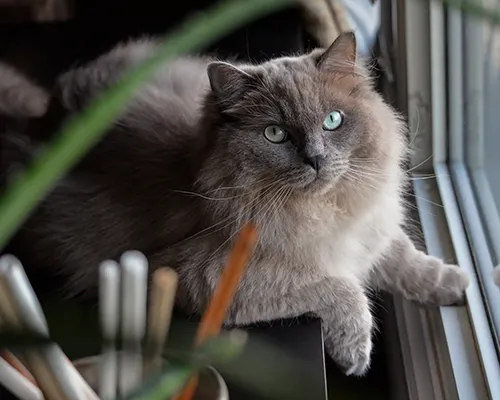Attention, feline fans: there’s a new cat in town! The Salty Licorice Cat wears a gorgeous coat that is in line with current fashion trends. These stunning cats, also known as salmiak cats (salted licorice cats), have ombre, or gradient, colored fur that is predominantly black at the roots and white at the ends. Continue reading to learn more about this cute kitten from a Gainesville, GA veterinarian.
Is the Salty Licorice Cat a new breed of cat?
Fluffy has not yet been formally recognized as a new breed. The name alludes to the hue of her coat. This also applies to many other felines, including tabbies and tuxedos.
Why is Fluffy known as the Salty Licorice Cat?
The cats have been named after a popular Finnish delicacy. As one might assume, it is made of licorice coated in salmiak salt. The treat, sometimes known as salmiak liquorice or salmiac licorice, is particularly popular in Scandinavia, northern Germany, and the Benelux countries.
What Is the Appearance of Salty Licorice Kitties?
Fluffy resembles a tuxedo cat, except that the dark portions of her coat are speckled with white. Salmiak cats’ deeper fur is typically black, although they can also have blue, brown, or tortoiseshell coats over the odd pattern. (We think the brown ones should be named Salted Caramel kittens, but that hasn’t occurred yet.) Their tails are usually white, or partially white. Fluffy’s eyes are typically a beautiful green or yellow tint.
Where Did the Salty Licorice Cat Come From?
Fluffy hails from the Finnish hamlet of Petäjävesi. The hamlet is located in a scenic setting and is well-known for its lakes, farms, and splendid 18th-century wood-log church. At the very least, it was known for these things. The Salty Licorice cat must now be added to the town’s roster of notable individuals, must-see attractions, and fascinating residents.
Why does the Salty Licorice Cat have such unusual fur?
It’s actually simple genetics. Hannes Lohi, a geneticist at the University of Helsinki, served as the head of the formal investigation, which was conducted by geneticists and animal rights activists.
Lohi’s team investigated five Salty Licorice cats. They observed that none of the cats had the precise gene alterations responsible for white fur. (Note: These changes are also associated with deafness, which explains why so many white dogs suffer hearing loss.) They next examined the kittens’ whole genomes and discovered a unique mutation in a gene called KIT. This gene is also linked to piebald patterns in horses and other animals.
In addition to the five Salmiak cats, the researchers recruited 178 other cats with normal fur for the study. All of the Salmiak kittens had two copies of the relevant gene variant, now known as w-sal or salmiak. A few other cats had a copy. Because the gene is recessive, neither of the hairy carriers could wear Salmiak colors or patterns.
The findings were published in May in the journal Animal Genetics.
What Year Was the First Salty Licorice Kitten Born?
Nobody seems to know where the Salty Licorice Cat came from or who took her in first. Fluffy rose to fame in 2007 after it was revealed that many of Petajavesi’s cats have unusual kitty fashion sense. Initially, no one knew whether the cats could reproduce because all feral felines of that color had been fixed. The mystery was solved when one of the stylish cats was spotted giving birth to some adorable kittens.
Is Licorice Safe for Cats?
We don’t recommend giving Fluffy licorice as a reward. On the other hand, it does not provide a significant threat to our feline pals, with the exception of the possibility that a cat could choke on a larger portion. In fact, studies show that it has anti-inflammatory qualities and may even help kitties with respiratory problems. However, more research is needed. In any case, do not give your pet any herbs or medications unless your Gainesville, GA veterinarian specifically instructs you to do so.
Putting that aside, it appears that certain cats prefer the flavor of licorice. Fluffy is most likely attracted to the texture or aroma. Our feline companions have a genetic quirk that stops them from tasting sweetness. Of course, some cats clearly didn’t get the message because they occasionally devour sweets like cake, cookies, and donuts. It would be nice to enjoy a donut with your cat, but you should refrain from giving her any sweet foods. Not only are they high in sugar, but many include xylitol, often known as birch sugar, which is harmful to cats.
Consult your Gainesville, GA veterinarian if you want to learn more about giving your cat treats.
What’s the Origin of Salted Licorice?
These little black candies first gained popularity in the 1800s. Galle and Jessen, Danish candymakers, are credited with originating and popularizing the long-lasting culinary fad. You have to agree that curling up on a cold night with a purring cat and a dish of goodies sounds quite appealing!
There are numerous recipes available online. These are essentially various variants on the same fundamental concept.
The typical recipe is as follows:
In a saucepan, add 8 tablespoons unsalted butter, 1 cup sugar, 1/2 cup sweetened condensed milk, 1/4 cup blackstrap molasses, and 1/8 teaspoon kosher salt. Bring to a boil. Then, remove from the fire and add one-half cup dark corn syrup, three-quarters cup whole wheat flour, one and a half tablespoons anise essence, and a half teaspoon black food dye. If you want to make things healthier, use condensed milk instead of heavy cream and dark corn syrup instead of brown rice syrup. Pour onto a parchment-lined pan, let cool for 30-45 minutes, then remove and shape. Don’t forget to sprinkle it with salt! You’ll want to let it cool again.
If you want to make these goodies, you can go the extra mile and buy a kitty-shaped mold. You can even call them katjes, which is their Finnish name. In fact, some candy producers have already implemented this!
Are Salty Licorice Cats Expensive?
It is tough to say right now. These lovely kittens are still rather uncommon. So yet, they have not left Finland. Although the Salted Licorice kittens are truly adorable, it is our unofficial responsibility as animal enthusiasts to raise awareness of the negative consequences of the designer breed obsession. Unfortunately, this leads to long-term problems such as pet overpopulation, hoarding, and abuse. The tagline ‘Adopt, don’t shop’ definitely applies here. Our feline companions make excellent pets, regardless of color! Many adorable, friendly felines at shelters are looking for a new home!
Conclusion: The Salted Licorice cat is not a new breed, but rather a new coat color. The kitties resemble tuxedo cats, but the darker parts of their coats are ‘frosted’ or salted’ with white. These adorable, fashion-forward felines are native to Finland’s Petäjävesi region and named after a favorite local snack: salted licorice.
Schedule an Appointment with Your Gainesville, GA Pet Clinic
Does your feline companion require a check-up, vaccinations, or parasite control? Has it been a while since your cat came indoors? Please contact us, your local Gainesville, GA pet clinic, for all of your cat’s veterinarian requirements. We are always happy to help.







!Social Media Icons